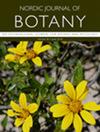亚洲“Calliandra”的研究导致了Sanjappa(蚕豆科-蚕豆科)的扩展
IF 1.1
4区 生物学
Q3 PLANT SCIENCES
引用次数: 0
摘要
Sanjappa属,以前在印度南部与单一物种S. cynometroides一起,扩展到包括S. umbrosa, comb。11月,在印度东北部,孟加拉国,缅甸和中国(云南)和越南南部,特别11月,在越南南部。Sanjappa与泰国的不同之处在于,它是泰国的姐妹属,它的叶外蜜腺是无柄的(相对于具柄的)腺体,有弹性开裂,而不是一粒状的豆荚(相对于非弹性开裂和亚一粒状的豆荚)。紫花参和越南参的不同之处是其双羽状叶有一对羽状叶(相对于只有两片小叶的简单羽状叶)和四裂花冠(相对于三裂花冠)。在伞花中,每个耳廓是2 - 3小叶,成对的托生刺主要存在于年轻的生长中,而在越南花中,每个耳廓是(3 -)4 - 5小叶,分枝,包括主要的分支,都有许多成对的具有加厚基部的刺。本文提供了三种树的同义词、图片和分布、生境、分类和保护的说明,并对其进行了分类。随着这里提出的分类变化,所有以前被视为Calliandra成员的亚洲物种都被容纳在这个属之外。本文章由计算机程序翻译,如有差异,请以英文原文为准。
Studies of Asian ‘Calliandra' lead to expansion of Sanjappa (Fabaceae-Caesalpinioideae)
The genus Sanjappa, previously with the single species S. cynometroides in southern India, is expanded to include S. umbrosa, comb. nov., in northeastern India, Bangladesh, Myanmar and China (Yunnan) and S. vietnamica, sp. nov., in southern Vietnam. Sanjappa differs from Thailentadopsis, its sister genus in the Zapoteca clade, by having leaves with extrafloral nectaries in the form of sessile (versus stipitate) glands and elastically dehiscent, not moniliform pods (versus pods not elastically dehiscent and submoniliform). Sanjappa umbrosa and S. vietnamica differ from S. cynometroides by having bipinnate leaves with one pair of pinnae (versus simply pinnate leaves with two leaflets only) and a four-lobed (versus three-lobed) corolla. In S. umbrosa each pinna is 2–3-foliolate and paired stipular spines are mainly present on younger growth, whereas in S. vietnamica each pinna is (3–)4–5-foliolate and branches, including major ones, are armed with numerous paired spines with thickened bases. Synonymies, images and notes on distribution, habitat, taxonomy and conservation for the three species of Sanjappa are provided, and all names are typified. With the taxonomic changes proposed here, all Asian species previously treated as members of Calliandra have been accommodated outside this genus.
求助全文
通过发布文献求助,成功后即可免费获取论文全文。
去求助
来源期刊

Nordic Journal of Botany
生物-植物科学
CiteScore
1.90
自引率
11.10%
发文量
100
审稿时长
2 months
期刊介绍:
Nordic Journal of Botany publishes original contributions on all aspects of the taxonomy, evolution, conservation, ecology and biogeography of plants (including algae and bryophytes) and fungi.
 求助内容:
求助内容: 应助结果提醒方式:
应助结果提醒方式:


